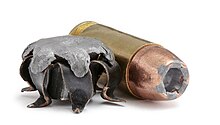





A hollow-point bullet is a type of expanding bullet which expands on impact with a soft target, transferring more or all of the projectile's energy into the target over a shorter distance.
Hollow-point bullets are used for controlled penetration, where overpenetration could cause collateral damage (such as aboard an aircraft). In target shooting, they are used for greater accuracy due to the larger meplat. They are more accurate and predictable compared to pointed bullets which, despite having a higher ballistic coefficient (BC), are more sensitive to bullet harmonic characteristics and wind deflection.
Plastic-tipped bullets are a type of (rifle) bullet meant to confer the aerodynamic advantage of the Spitzer bullet (for example, see very-low-drag bullet) and the stopping power of hollow-point bullets.